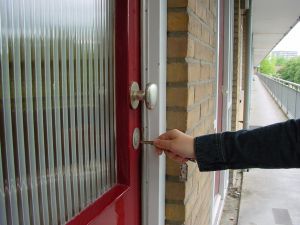Posted by Teresa on September 11, 2009 under Landlord and Tenant FAQs, Landlord Tips | 
 What are the guidelines when it comes to a landlord’s ability to enter a tenant’s apartment or house? It depends on your state’s laws, but in most, the landlord must provide notice prior to entering a tenant’s home.
What are the guidelines when it comes to a landlord’s ability to enter a tenant’s apartment or house? It depends on your state’s laws, but in most, the landlord must provide notice prior to entering a tenant’s home.
Do check your state’s landlord/tenant laws: they can range from “no notice required” in Massachusetts, New Jersey, and several other states; to 12 hours in Florida; to 48 hours in Vermont.
Don’t worry about advance notice in cases of emergency, such as natural gas odor, smoke or fire, or a water leak.
Don’t “knock and unlock.” Allow your tenants to answer the door, even if they are expecting you.
Don’t assume they’re not at home and let yourself in.
Do offer more than the required notice if you can.
Do specify a window of time they can expect you. And try to stick to it. Call them if you’re delayed or early.
Do leave your tenant’s home in the same condition you found it. If your shoes are muddy, remove them before entering. And clean up after yourself.
Do conduct inspections and maintenance on your rental properties with the goal of maintaining your tenants’ privacy, too!
Posted by Teresa on February 18, 2009 under Landlord Tips | 
You’ve worked hard to prepare and market your rental property, and now you’ve found a great new, pre qualifed tenant. If you think the hard work is behind you, guess again! Now it’s your job as property manager to retain your good tenant—after all, you want to minimize tenant turnover.
Consider providing a Welcome Package that answers your tenant’s questions and clarifies everyone’s expectations. It’s a small, but significant, step toward building a good landlord-tenant relationship.
Include an overview of rules and policies, but don’t restate the entire lease. A simple list for referral purposes is enough. Include when and where to pay rent, how to access the building, where to park, and any other pertinent information. This can be accomplished with an FAQ (Frequently Asked Questions) list.
Be sure to provide practical safety information, such as an evacuation route, fire extinguisher locations, and emergency water shut-offs. A floor plan clearly indicating these items would be perfect.
A phone number list is essential for new renters. Include your own regular and emergency contact numbers, as well as those of your preferred maintenance service, plumber, and electrician. If a crisis situation occurs, your tenants should be able to get the help they need, even if they cannot reach you. Make sure your tenants know how to reach all of the property’s utility providers, too.
A guide to nearby restaurants, grocery stores, dry cleaners, and coffee shops would be most appreciated by a tenant who is new to your town. Tell them where the best pizza can be found, so they’re prepared to order dinner on move-in day. Visit your Chamber of Commerce or local Visitor’s Center for brochures and area guidebooks.
If you’re really dedicated to establishing a great relationship, the Welcome Package might include a few move-in necessities to help your new tenants transition to their new home. Think about the items most needed when moving—like bottled water, paper towels, soap, a roll of t.p. for the bathroom, and even a gift certificate to a local pizzeria. You’ll demonstrate you are going above and beyond to improve the landlord/tenant relationship!
Find landlord resources, including everything you need to know about tenant screening, from E-Renter.com.
Next post: Establishing A Property Inspection Schedule
 What are the guidelines when it comes to a landlord’s ability to enter a tenant’s apartment or house? It depends on your state’s laws, but in most, the landlord must provide notice prior to entering a tenant’s home.
What are the guidelines when it comes to a landlord’s ability to enter a tenant’s apartment or house? It depends on your state’s laws, but in most, the landlord must provide notice prior to entering a tenant’s home.